Sit’s nicely in the palm this one. Love the markings produced by smoke permeating the layers of clay resist.

Sit’s nicely in the palm this one. Love the markings produced by smoke permeating the layers of clay resist.


View this post on Instagram
These garden sculptures were exhibited at the amazing Sculpture at Kingham Lodge 1-9 May 2021.
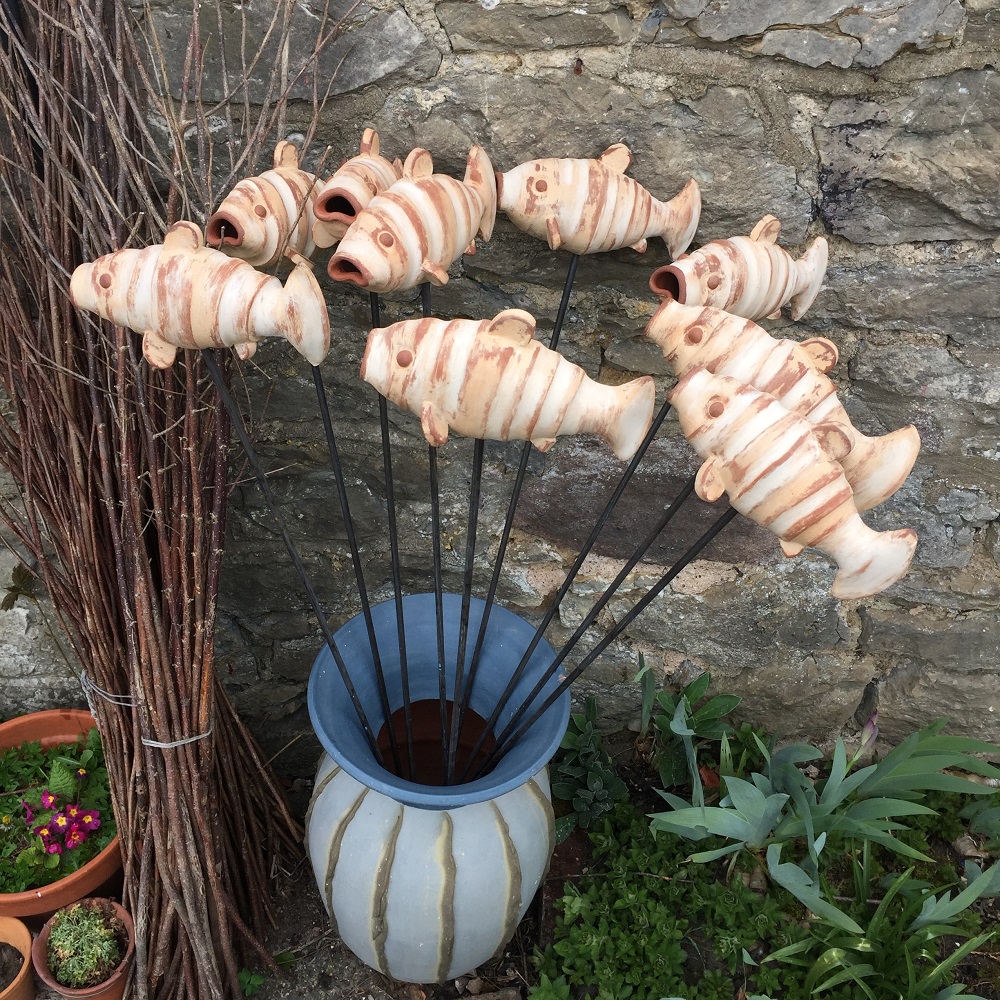
Not sure what’s the collective term for a pot full of ceramic fish!?

This shoal will be swimming at the magnificent Sculpture at Kingham Lodge exhibition. 1-9 May 2021.
Set in 5 acres of beautiful grounds, over 400 sculptures are displayed as you would like to see them in your own garden. Prices start at £10 so there is something for everyone!
The exhibition is part of the wider Oxfordshire Art Week and although entrance is free to Kingham, you do have to book your viewing slot due to covid-19 restrictions.


Taking time to appreciate the subtle effects of layering and wiping away slip decoration….

At the moment, these snail sculptures are at the leather hard stage (my favorite!) and still have to dry for a couple of weeks before going in the kiln.

Once they’ve been fired, the snails are to be exhibited at several garden sculpture exhibitions later this year.
As with a lot of my work, these pieces have an interactive element. Visitors will be able to gently rock the snails back and forth to create rhythmic sounds.


I love making these!!! – so much fun to produce! ??
They start life on the potters wheel as thin, solid cones. Texture is added whilst the clay spins and each one finally curled from the tip down.
They’re insect antennae, added to the bodies of sculptural bees, bugs and snails. ? ? ?
That said, I reckon they hold their own as mini-sculptures reminiscent of unfurling ferns or organic iron work.
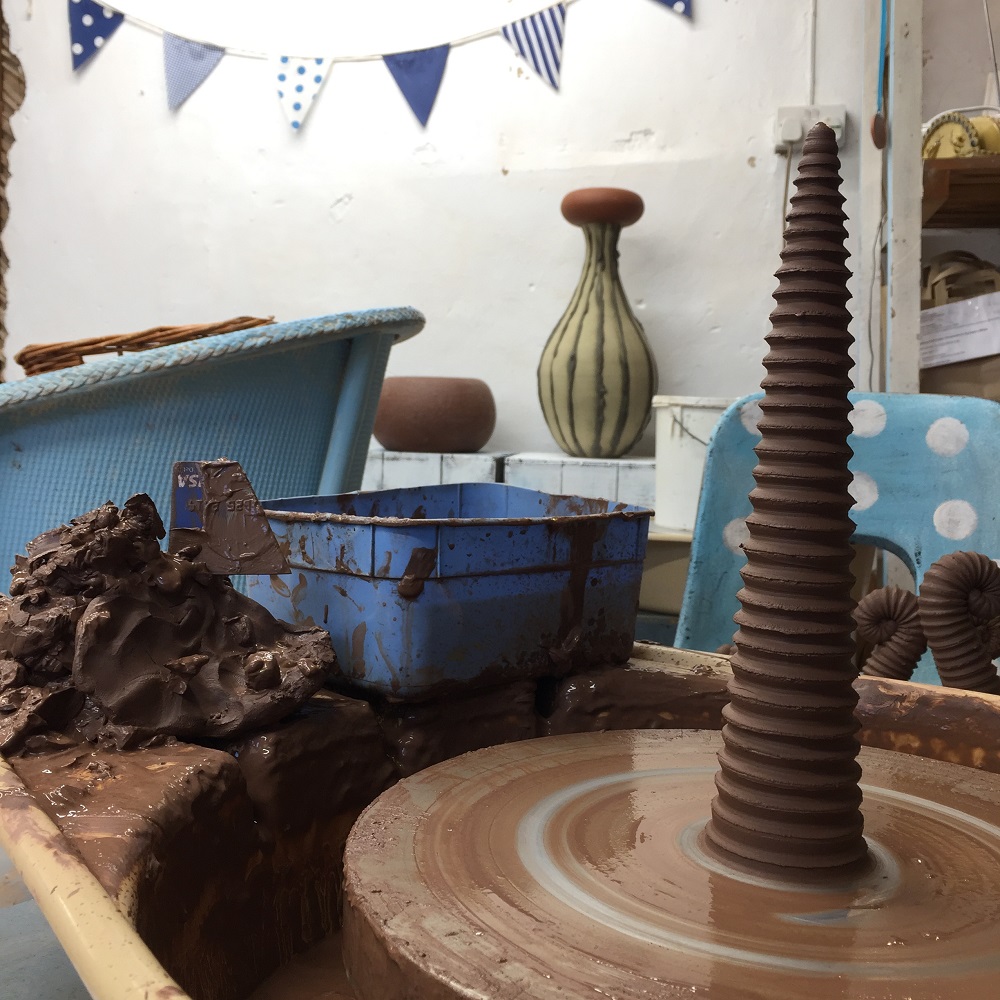

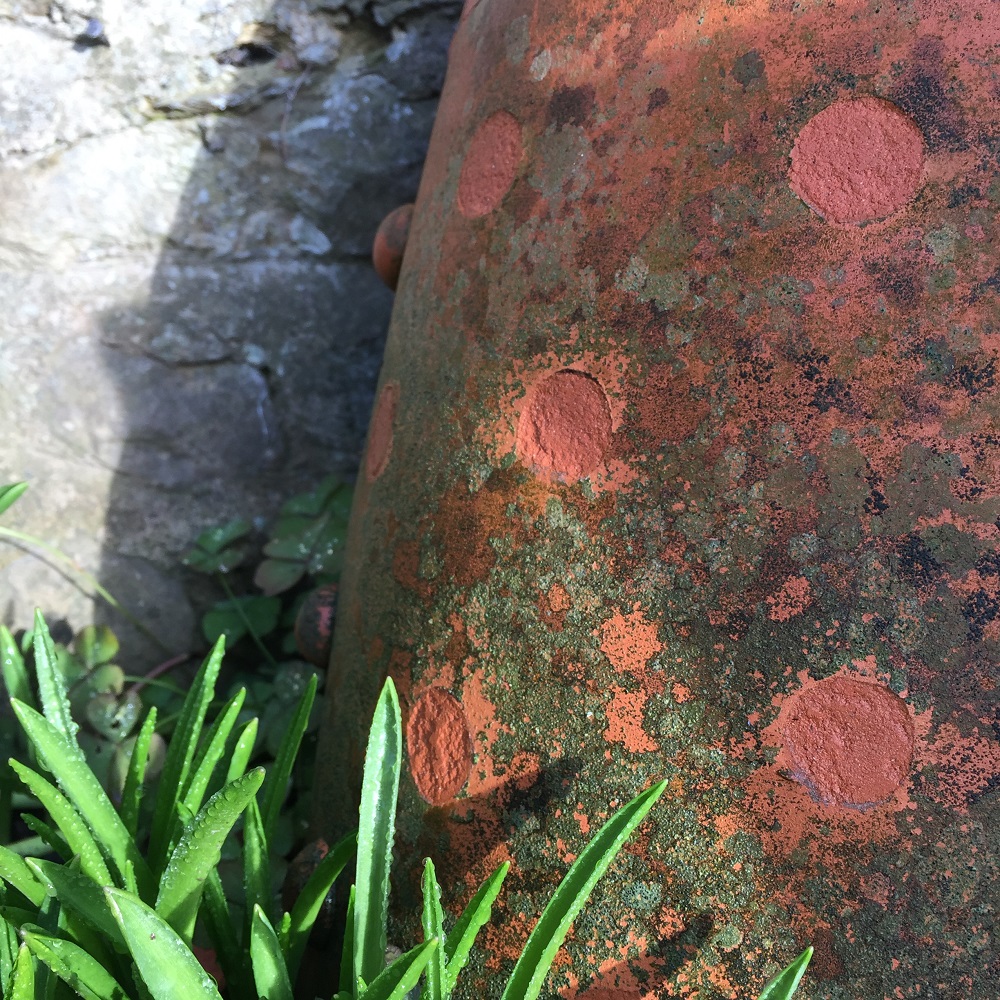
It’s amazing how a terracotta pot can survive outside in the garden for decades. Season after season it is resilient against the very worst the British Winter can hurl at it. And then, all of a sudden, it quite literally falls to pieces.
Frost damage occurs when water, absorbed into the ceramic wall freezes and expands. The force is strong enough to ‘spit out’ little chunks leaving the surface pot marked. Sometimes the force is strong enough to crack the vessel in two!
This button planter made by myself in the 1990’s with all it’s applied half spheres, lived happily and in tact, in the garden here at Eastnor pottery. Then out of the blue, quite recently, after a particularly wet and cold period, the planter shed all it’s buttons.
I can only deduce that the days of persistent rain had penetrated and saturated the pot. Under normal circumstances the pot would dry naturally, minimising the effect of the freezing water. On this occasion the sudden, plunging temperatures shortly after the deluge was sufficient to reek havoc. The conditions were spot on – a perfect storm!
I like the effect though – The area beneath the buttons resisted the lichen patina. When the buttons popped off, they left a satisfying terracotta polka dot pattern. Nature is the best artist!

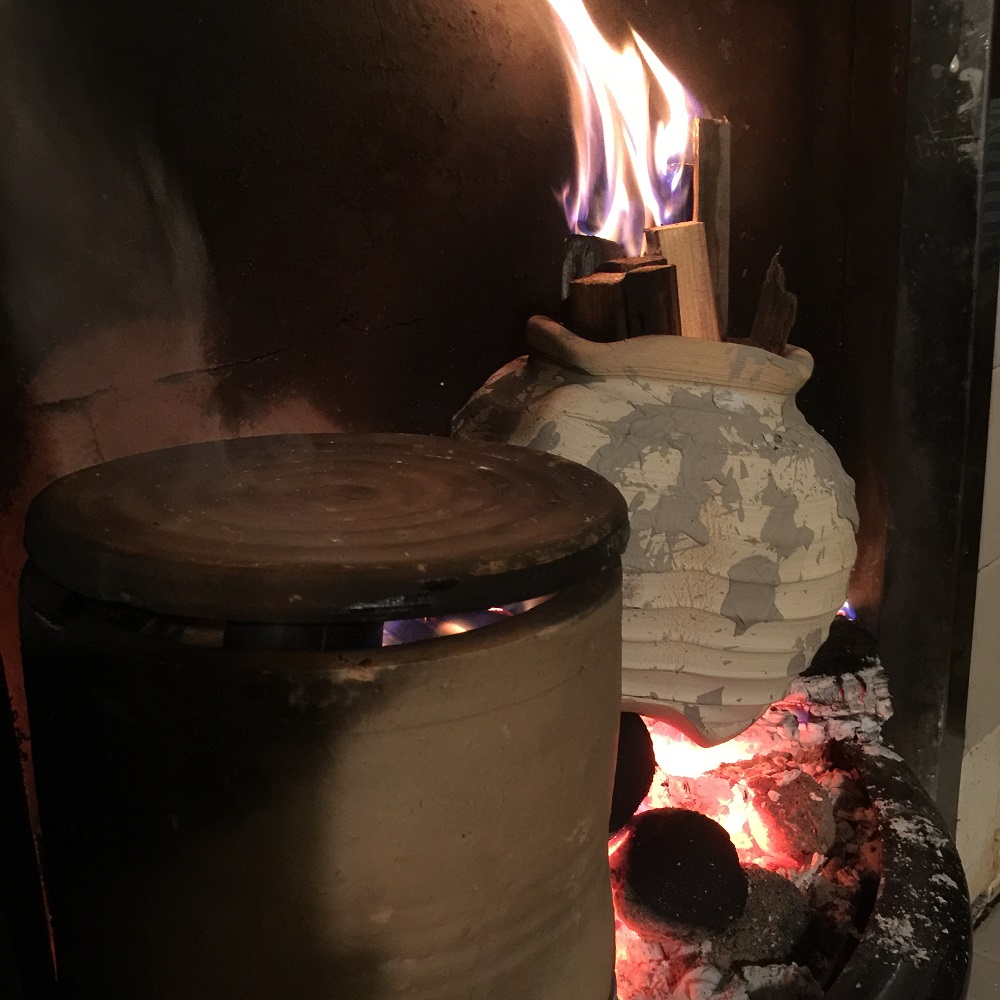

Whilst experimenting with smoke fired pottery on the BBQ last Spring, I found a lot of my pots developed hair-line cracks and fissures due to the thermal shock of the flames licking the ware. There was only one course of action – make myself some saggers!
Those of you who might not be familiar with the word, a sagger is a protective fire-clay box enclosing ceramic ware while it is being fired.
Traditionally, they were used in the pottery industry to protect the pottery whilst it was fired in huge bottle kilns.
Above are some fine examples of antique saggers, piled high at Gladstone Pottery Museum in Stoke. They’ve obviously seen some action and been in and out of the kiln many many times, protecting their precious contents from the ferocity of the fire. The pitted and roasted surfaces really tell a story – I love the effect!
I used brick clay to make my saggers – x3 crude and rather brutal looking cylinders with lids made on the potter’s wheel and fired to 960 degrees.
Not only do the saggers prevent cracking, but I have produced some really intense blacks by packing combustible materials around the work inside the sagger. The twigs and sawdust inside the sagger smolder in the oxygen deprived atmosphere rather than burst into flame. This produces a lot of smoke which permeates the ceramic surface with great effect.

I’ve had so much fun experimenting with the saggers over the Autumn and Winter, firing them on the BBQ, bonfires and inside the house in the fireplace during the colder months.

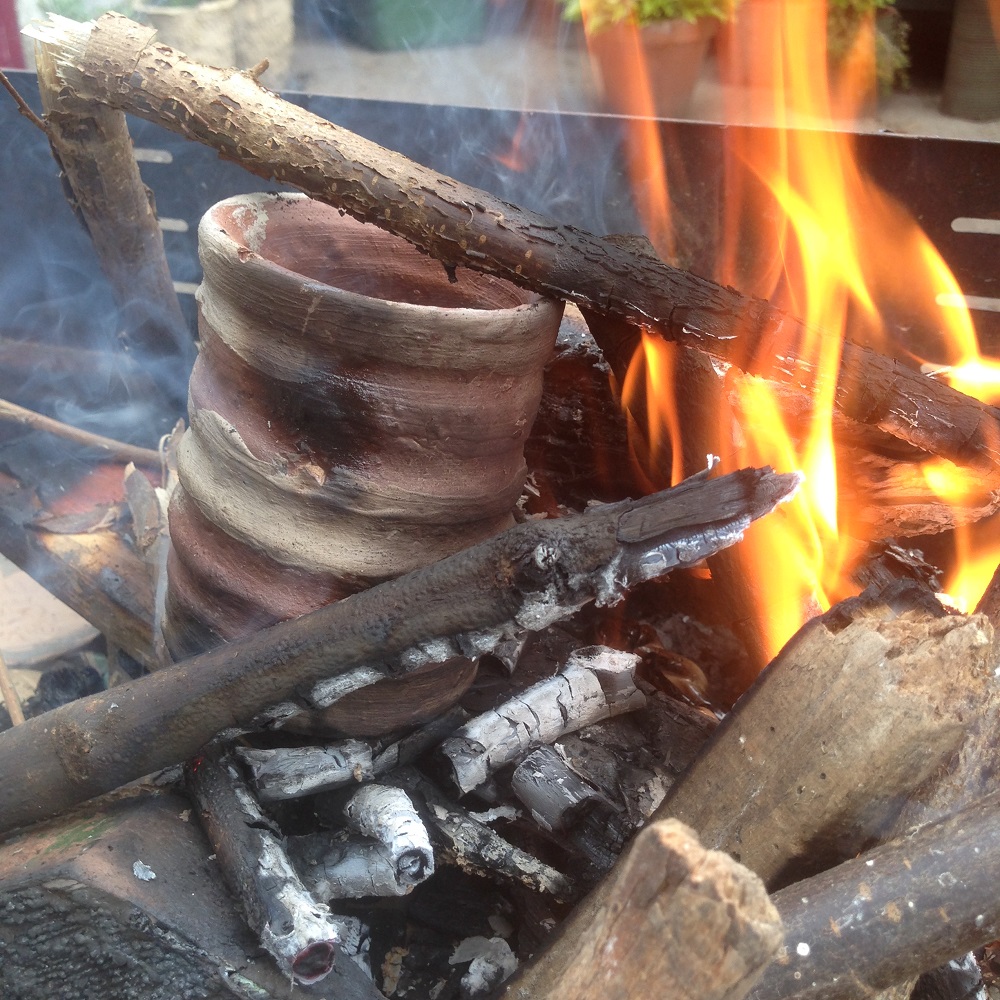
In an attempt to add further depth to my ceramic surfaces, I’ve been messing about with fire in the Pottery garden.

I had dabbled with smoke firing once before in my role as an artist in residence at Evesham Nursery School. I have very fond memories of working with the staff and children in their amazing Forest School site on the outskirts of town.
The young artists had great fun painting thick wet slip onto bisque pots they’d created on one of my previous visits to the Nursery.
Once the pots, leaves, staff and children’s faces! had been daubed in slip, we set about building a fire around the pots, watching as the flames and smoke curled around the children’s creations.
When the fire had died down, we carefully extracted the scorching pots using raku tongs and plunged them into a bucket of water, admiring the sizzling, bubbling and frothing as they sunk to the bottom.
As soon as the pots were cool enough to handle, the children set about removing ash and scrubbing away the painted slip to reveal the pale terracotta – a terrific contrast to the blackened, smoked areas of the unmasked surface.
I remember being encouraged and inspired by the children’s results and keen to try out the process for myself. Unfortunately, as with a lot of things, I never seemed to find the time to explore the technique. That is until Lock down!
I discovered an amazing website called Ceramic Arts Network, packed full with articles and accessible features. My fave being how to smoke fire pots on a BBQ!

I have learnt so much from the first firing (thermal shock can be so frustrating!) and am looking forward to trying again using saggars to protect and pattern the work.


Tree Pringles!
The latest incarnation of x30 or so wheel thrown disks.
They made their debut at Fresh Air Sculpture Exhibition a few years back as a purely sculptural piece, stacked one on top of another to form two floor standing totems.
Since then, I’ve been experimenting with the work as an interactive resource in all sorts of settings and environments.
View this post on Instagram
They make excellent rocking pots too!
View this post on Instagram
They’ll have their next outing at the rescheduled Hellens Garden Festival 22 & 23 August 2020.

Outside learning with nursery aged children in the depths of winter – chilly, great fun and a fine example of partnership and collaborative working! Just look at the individuals and organisations involved:
Jon Williams
I made ceramic play things and clay stamps as a response to the exploratory sessions with the very young children and their teachers. The work was then gifted to the school to as a resource for future outdoor learning.

The Craftplay project brought together WAVE and Craftspace who worked together at Bilston Craft Gallery to deliver a programme of creative engagement sessions with early years’ children. The project engaged with children and their carers through working with craft makers to explore creative play and the natural environment – investigating the part craft plays in developing a sustainable future. By taking the world around us as a teacher and actively interacting with, The Craftplay project sought to inspire children with an appreciation of the environment and its systems, and to enrich their self-belief through creating things themselves by hand.
There is an acute need to support basic wellbeing in the area immediately around Bilston Craft Gallery which has high concentrations of children living in poverty and high levels of deprivation. The sessions provided by the Craftplay project offered a rich, inspiring and fun learning environment where curiosity, confidence and social development were nurtured. In order to chart the progress of their project, WAVE and Craftspace created a great blog.
Read a Case Study of the project – Bilston Craft Gallery – developing outdoor play